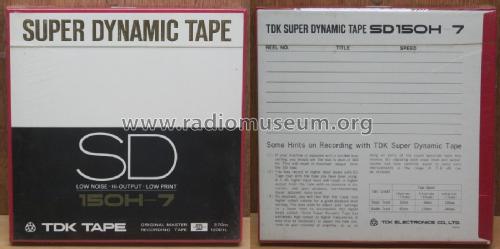Sound Recording Tape All
TDK Corporation; Tokyo
- Land
- Japan
- Hersteller / Marke
- TDK Corporation; Tokyo
- Jahr
- 1960 ??
- Kategorie
- Diverses (Sonstiges) - siehe Bemerkungen
- Radiomuseum.org ID
- 265661
- Wellenbereiche
- - ohne
- Spezialitäten
- Spezialband- oder -Kassette
- Betriebsart / Volt
- Keine Stromversorgung
- Lautsprecher
- - - Kein Ausgang für Schallwiedergabe.
- Material
- Diverses Material
- von Radiomuseum.org
- Modell: Sound Recording Tape [All] - TDK Corporation; Tokyo
- Form
- Diverse Formen, unter Bemerkung beschrieben.
- Bemerkung
-
This page is for all TDK open reel sound recording tapes.
Please do not modify this page.
Load only pictures with all data in the picture legend!
Diese Seite ist für alle Marke TDK Tonbandspulen.
Bitte nur Bilder hochladen, alle Informationen/Daten in die Bildlegende.
History: (Extracts taken from Wikipedia)
"Magnetic tape is a medium for magnetic recording, made of a thin magnetizable coating on a long, narrow strip of plastic film. It was developed in Germany, based on magnetic wire recording. Devices that record and play back audio and video using magnetic tape are tape recorders and video tape recorders. A device that stores computer data on magnetic tape is a tape drive (tape unit, streamer). Magnetic tape revolutionized broadcast and recording. When all radio was live, it allowed programming to be recorded. At a time when gramophone records were recorded in one take, it allowed recordings to be made in multiple parts, which were then mixed and edited with tolerable loss in quality. It is a key technology in early computer development, allowing unparalleled amounts of data to be mechanically created, stored for long periods, and to be rapidly accessed. Nowadays other technologies can perform the functions of magnetic tape. In many cases these technologies are replacing tape. Despite this, innovation in the technology continues and companies like Sony and IBM continue to produce new magnetic tape drives. Over years, magnetic tape can suffer from deterioration called sticky-shed syndrome. Caused by absorption of moisture into the binder of the tape, it can render the tape unusable."
Auszug aus Wikipedia:
"Ein Tonband (Magnettonband) ist ein Stahl-, Papier- oder Kunststoffband, das mit magnetischen Stoffen, speziellen Metalloxiden (z. B. Eisen(III)-oxid) oder Reineisenpulver beschichtet ist. Es dient in entsprechenden Audiorekordern als magnetisches Speichermedium für analoge oder digitale Audiosignale (Sprache, Musik, Geräusche). Bandbreite und Spulengröße Die Breite des Bandes betrug bei den Pfleumerschen Versuchen anfänglich 16 mm (es wurden 16-mm-Filmspulen verwendet), später im Experiment ca. 10 mm, dann bei der AEG vor dem Zweiten Weltkrieg 6,5 mm. Nach Abtransport der deutschen AEG-Geräte nach den USA wurde der 6,5-mm-Standard auf 1/4 Zoll (6,35 mm) geändert. Weiterhin wurde die magnetisierbare Seite (Schichtseite) des Bandes von außen nach innen verlegt, man spricht von „Internationaler Schichtlage“. Beim deutschen Rundfunk wurde öfter mit der Schichtlage außen („Deutsche Schichtlage“) und nur mit freitragenden Spulenwickeln auf einem „Bobby“ (AEG-Wickelkern) gearbeitet. Bei der Compact Cassette ist die Magnetschicht aus technischen Gründen außen. Seit Kriegsende beträgt die Breite 1/4" = 6,35 mm oder ein Vielfaches davon – bis hoch zu 2-Zoll-Bändern bzw. nur 0,15" (3,81 mm) bei der Compact Cassette. Das Magnetband wird auf Spulen mit einer Länge von bis zu weit über 1000 Metern aufgewickelt. Der Durchmesser der Spulen für die Tonbänder reicht von 6 cm über 8, 10, 11, 13, 15, 18 und 22 bis 26,5 cm, in alten Rundfunkstudios und in den USA sogar bis 16" (etwa 41 cm). Der Ton wird auf einer oder auf mehreren Spuren gleichzeitig aufgezeichnet. Es gibt digitale 48-Spur-Geräte und analoge mit sogar bis zu 64 Spuren."
- Autor
- Modellseite von einem Mitglied aus A angelegt. Siehe bei "Änderungsvorschlag" für weitere Mitarbeit.
- Weitere Modelle
-
Hier finden Sie 11 Modelle, davon 9 mit Bildern und 1 mit Schaltbildern.
Alle gelisteten Radios usw. von TDK Corporation; Tokyo
Sammlungen
Das Modell Sound Recording Tape befindet sich in den Sammlungen folgender Mitglieder.


